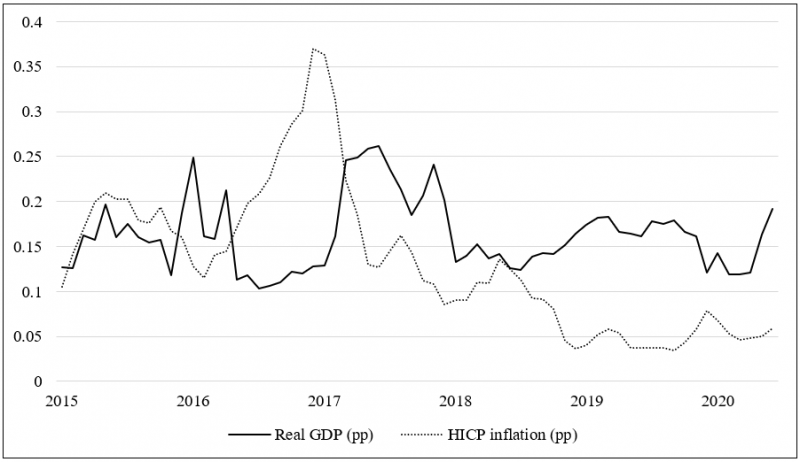References
Altavilla, C., Burlon, L., Giannetti, M., Holton, S. (2019). Is There a Zero Lower Bound? The Effects of Negative Policy Rates on Banks and Firms. ECB Working Paper, No. 2289, June 2019 (revised June 2020). 54 p.
Andrade, P., Breckenfelder, J., De Fiore, F., Karadi, P., Tristani, O. (2016). The ECB’s Asset Purchase Programme: an Early Assessment. ECB Working Paper, No. 1956, September 2016. 63 p.
Antolin-Diaz, J., Rubio-Ramirez, J. F. (2018). Narrative Sign Restrictions for SVARs. American Economic Review, vol. 108, No. 10, October 2018, pp. 2802–2829.
Arias, J. E., Rubio-Ramirez, J. F., Waggoner, D. F. (2018). Inference Based on Structural Vector Autoregressions Identified with Sign and Zero Restrictions: Theory and Applications. Econometrica, Vol. 86, issue 2, March 2018, pp. 685– 720.
Barth III, M. J., Ramey, V. A. (2002). The Cost Channel of Monetary Transmission. NBER Macroeconomics Annual 2001, vol. 16, January 2002, pp. 199-256.
Bobeica, E., Sokol, A. (2019). Drivers of Underlying Inflation in the Euro Area Over Time: a Phillips Curve Perspective. ECB Economic Bulletin, Issue 4/2019.
Boehl, G., Goy, G., Strobel, F. (2020). A Structural Investigation Of Quantitative Easing. De Nederlandsche Bank Working Paper, No. 691, August 2020. 49 p.
Borio, C., Zabai, A. (2016). Unconventional Monetary Policies: a Re-appraisal. BIS Working Papers, No. 570, July 2016. 49 p.
Christiano, L. J., Eichenbaum, M., Evans, C. L., (2005). Nominal Rigidities and the Dynamic Effects of a Shock to Monetary Policy. Journal of Political Economy, vol. 113, issue 1, February 2005, pp. 1-45.
Debortoli, D., Galí , J., Gambetti, L. (2020). On the Empirical (Ir)Relevance of the Zero Lower Bound Constraint. NBER Macroeconomics Annual, vol. 34, issue 1, pp. 141-170.
Eser, F., Karadi, P., Lane, P. R., Moretti, L., Osbat, C. (2020). The Phillips Curve at the ECB. ECB Working Paper, No. 2400, May 2020. 51 p.
Jarociński, M., Karadi, P. (2020). Deconstructing Monetary Policy Surprises – The Role of Information Shocks. American Economic Journal: Macroeconomics, vol. 12, issue 2, April 2020, pp. 1-43.
Kiley, M. T. (2018). Quantitative Easing and the “New Normal” in Monetary Policy. Finance and Economics Discussion Series of Board of Governors of the Federal Reserve System, No. 2018-004, January 2018. 40 p.
Primiceri, G. E. (2005). Time Varying Structural Vector Autoregressions and Monetary Policy. The Review of Economic Studies, vol. 72, issue 3, July 2005, pp. 821–852.
Ravenna, F., Walsh, C. E. (2006). Optimal Monetary Policy with the Cost Channel. Journal of Monetary Economics, vol. 53, issue 2, March 2006, pp. 199-216.
Rostagno, M., Altavilla, C., Carboni, G., Lemke, W., Motto, R., Saint Guilhem, A., Yiangou, J. (2019). A Tale of Two Decades: the ECB’s Monetary Policy at 20. ECB Working Paper, No. 2346, December 2019. 339 p.
Williams, J. C. (2016). Monetary Policy in a Low R-star World. FRBSF Economic Letter 23. 6 p.
Zlobins, A. (2020). ZLB and Beyond: Real and Financial Effects of Low and Negative Interest Rates in the Euro Area. Latvijas Banka Working Papers, No. 2020/06, December 2020. 40 p.
Zlobins, A. (2021). On the Time-varying Effects of the ECB’s Asset Purchases. Latvijas Banka Working Papers, No. 2021/02, October 2021. 47 p.




